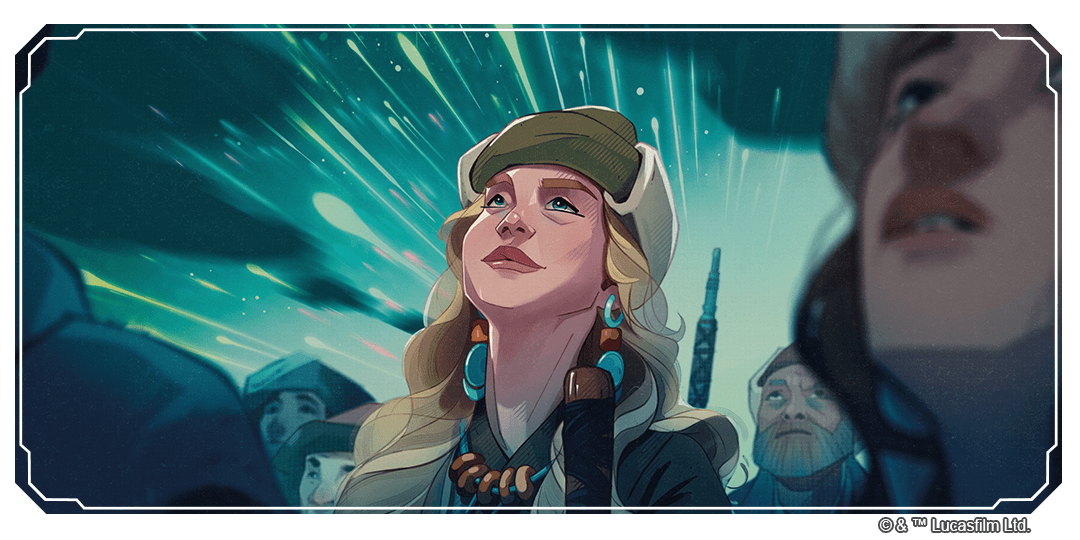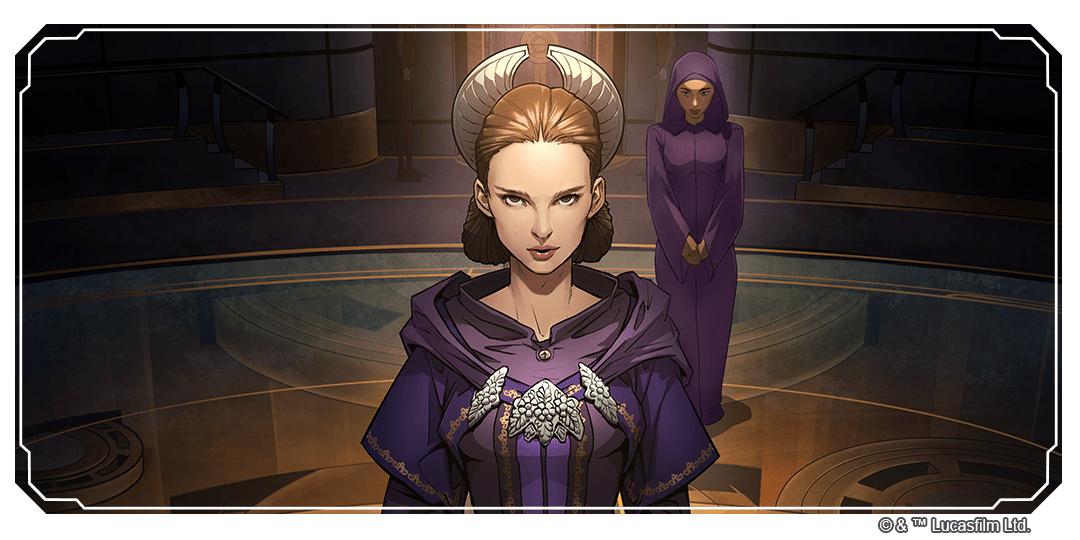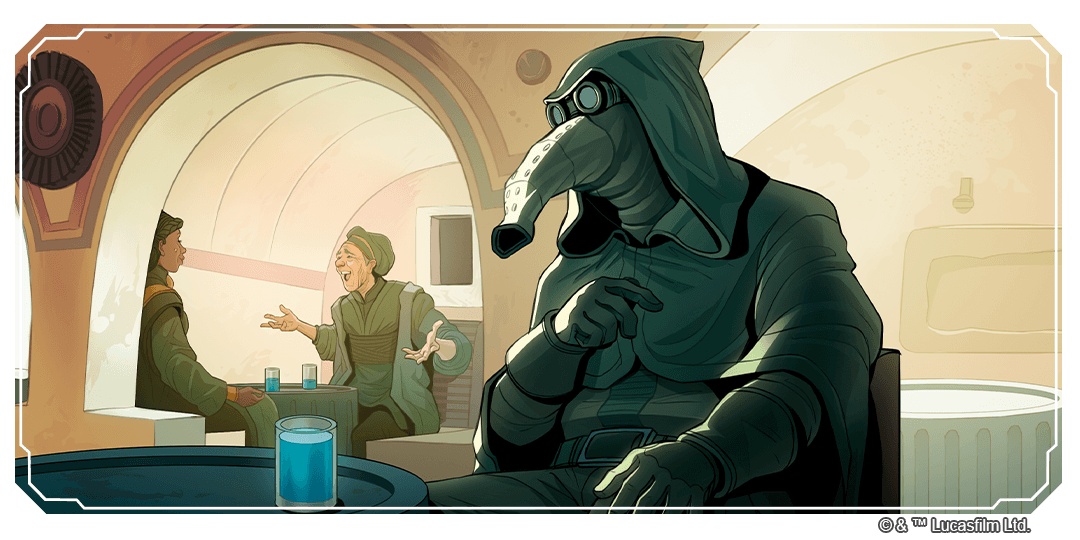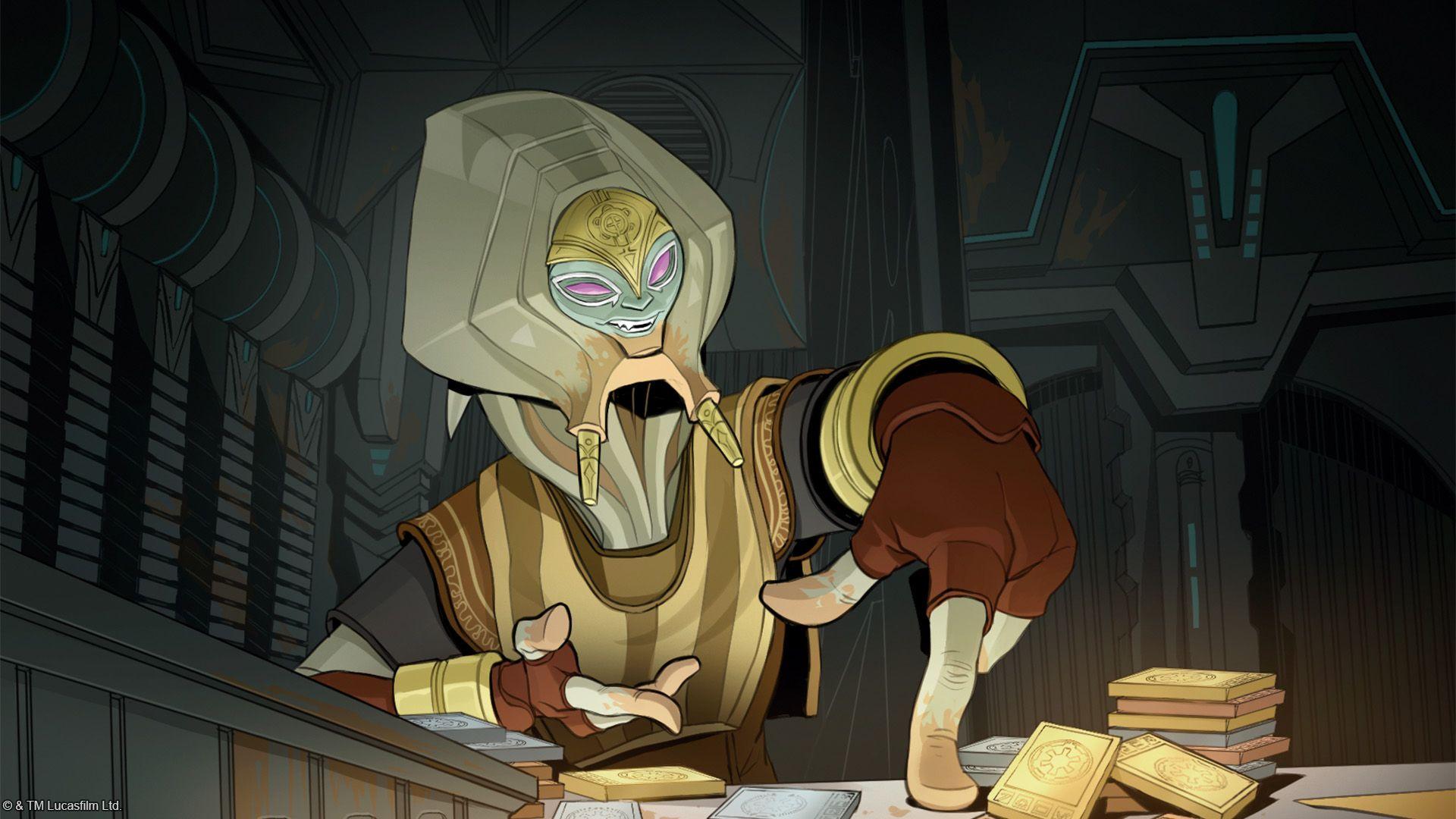Behind Unlimited: Designing Secrets
November 20, 2025 | Written by Tyler Parrott

From the beginning, Secrets of Power was a passion of mine. I have a personal interest in how people relate to each other, how they communicate, and how their values hold up under scrutiny. Subtext is fascinating, and you can learn a lot about people when they talk to you. Since Star Wars™: Unlimited is a game where two people sit across from each other, I wanted to design a set that leaned into those interpersonal interactions. Could we expand the scope of what the game could be by leaning back from the game board and interacting directly with the opponent?
Thus, I pitched my “schemes and intrigue” set for the third set of 2025. We had known for much of the first year that we wanted to make a set about pilots and a set about the Force, but the third set was a blank slate. As I had a clear vision for what kind of set I would want to make—and it contrasted meaningfully from the two sets before it—I proposed a set about intrigue and information, a set that asked players to compete with their opponent in a new, less direct way. The pitch was strong enough that Danny and leadership immediately approved it, and it waited in the wings for many months until it was time for us to begin.

Integrating a Theme
Alongside my vision for a game experience that involved manipulating information and trying to get directly into the opponent's head, I also had a thematic goal for the set: create a Padmé Amidala Spotlight Deck. Padmé is one of my personal favorite characters in Star Wars, but because she's (mostly) not an action hero, it would be very difficult for her to make sense as the “face” of most sets. However, she's one of the most well-known characters in the franchise, and she caters to a demographic of fans that the TCG industry doesn't naturally cater to, making her extremely effective as a face character for marketing a set. Since her skill set is in politics—and since political intrigue is a major theme of the Star Wars prequels (and the Clone Wars show)—it felt like a natural identity for a set built around interpersonal intrigue and around Padmé. This would naturally be supported by her primary antagonist, Chancellor Palpatine, who also operated in the political arena.
Alongside all of my enthusiasm for the idea of a set that highlighted the machinations between Padmé and Chancellor Palpatine (and others), I got extremely lucky. I pitched the concept for the set in August of 2022, which is when we decided on the set themes for 2025. One month later, Andor—a show entirely about spies and intrigue—released to critical acclaim. I honestly don't know what Secrets of Power would look like without Andor because of how immediately the themes and content of that show flawlessly integrated with the themes and mechanics of the set.
The addition of Andor allowed us to move away from some of the more overtly-political elements of the set and towards something more appealing to a wider audience. The names of two of the set's mechanics changed (“petition” became “disclose” and “Aides” became “Spies”) and the leader lineup got rewritten to include the main characters of the show. We would sneak Luthen Rael (Legends of the Force, 68) into Legends of the Force as the set's antiquarian, but all of the internal excitement for the new show got directed straight at Secrets of Power as the best home for all of those characters. This development also helped guide us towards other intrigue-heavy characters, especially in the criminal underworld space. The underworld may not have Officials in this game, but the idea that Jabba the Hutt (Secrets of Power, 2) or Dryden Vos (Secrets of Power, 7) would be negotiating and making deals was an easy justification for their inclusion.

Hiding And Revealing
The original vision for the set revolved around the play pattern of hiding and revealing information from your opponent. I wanted players to be thinking about what their opponent might have, and to try to manipulate their opponent's gameplay decisions with bluffs and misdirections. The obvious starting place for such mechanics is, of course, a player's hand of cards. The image of two card players staring at each other—trying to read each other's expressions and tells while holding cards that only they can see—is iconic, and it served as a guiding direction for how I designed the mechanics of the set.
Disclose, therefore, existed basically unchanged from the beginning. The idea that I could manipulate my opponent by giving them partial information was extremely compelling to me, and the added uncertainty of the game's resourcing mechanic really perfected its inclusion. The small act of revealing a card from my hand could influence player behavior in so many ways:
- It could intimidate my opponent (“this is coming and there's nothing you can do to stop it”)
- It could make my opponent play around the wrong threat (“you play around what I show you, not what I will actually do”)
- It could make my opponent play around a non-existent threat (“you play around a card I showed you, but then I resource it”)
- It could make my opponent overthink their own tactics (“they fail to play around the threat I show them because they incorrectly think I resourced it to trick them”)
- It could even make me care about the cards in my own hand in a new way, because the need to have the right disclose combinations resulted in unique resourcing or sequencing decisions.
All of these use-cases for disclose made it immediately popular with internal players, and it had the effect I was looking for, which was to change players' play patterns and increase variety. It also had the side effect of encouraging players to have more cards in their hand than they were used to, which resulted in more opportunities for the set's themes to shine, as games now involved more hidden information.

While disclose basically didn't change for the entirety of the set's design process, Plot underwent foundational transformations. Because of the set's “schemes and intrigues” theme, I wanted very badly for it to be called “Plot,” which dictated some of its design goals as well. After all, Palpatine as a character is, in many ways, defined by all the plotting he does! So, as a hidden-information mechanic called “Plot,” it had a few important experiential goals:
- It involved explicitly hiding information from the opponent (“I'm hiding information from you, and you know it”)
- It involved setting up a plan in the early game that executed later in the game (“I'm planning several rounds ahead”)
- It involved a moment of dramatic revelation (“witness the execution of my plot!”)
- It encouraged you to wait as long as possible to execute on your schemes (“the longer I wait, the more plots I can put into motion”)
- It could be disrupted by the opponent (“you have foiled my plot!”)
- It operated within the normal Star Wars: Unlimited game loop (“we're still playing cards and attacking with units”)
With these goals in mind, I considered how we could execute these goals in a way that was clear, direct, and exciting. What I put into the first vision for the set, then, was a mechanic that combined a pair of existing mechanics that I loved from other games. The first draft of Plot looked like this: you would pay 1 resource to “initiate” a plot facedown alongside your base with 1 “progress counter” on it. Each round, all of your plots would gain 1 progress counter. When an opponent's unit in either arena attacked, they could choose to attack your units, your base, or one of your plots. If the unit attacked your plot, the plot would be immediately defeated and all of its progress would be moved to the attacker as damage. When you took an action to play a card, you could play a card from your hand or you could play one of your facedown plots, reducing its cost by 1 for each progress on it. If you waited long enough, your plot would be free! Obviously, Plot would change dramatically during its design process (a story I will tell in full in a future article).

While the set's primary mechanics were built around hiding and revealing information, however, there were a couple other mechanics that were important for the set to include. The first were Spy tokens, a token I had designed when I was iterating on token unit ideas after completing Twilight of the Republic (I really enjoy designing tokens). I wanted a token unit that was weak enough that we could put it incidentally on a lot of card abilities, but strong enough that the opponent couldn't ignore it. I especially wanted this token to be able to be added as a secondary effect to a bunch of events, so that both players playing a normal game would result in random small-but-meaningful units populating both sides of the board. Having more targets to attack—but not always making it obvious that they needed to be attacked—would make combat decisions more interesting for both players. Would my opponent consider my Spy a threat, such that I need to attack with it first, or can I attack with my stronger unit first? Was my opponent's Spy something that I would need to exhaust a unit to deal with, or could I get away with ignoring it and continuing to pressure my opponent's base? By making the token a 0/2, attacking it was trivial (so the cards that created them could cost less), but the Spy couldn't be taken out by incidental damage. By giving the token Raid 2, its attacks dealt a meaningful amount of damage such that a handful of Spies couldn't be ignored for long. It also meant that the Spy vs Spy action made sequencing and initiative that much more important, something we wanted to explore in this set.
The second supporting mechanic for the set was capture, which was returning from Shadows of the Galaxy and Twilight of the Republic. Given the set's themes of indirect and non-violent conflict, capture was an obvious inclusion for the set as a way that we could have abilities that remove a unit but don't defeat it. And there's so much capturing that happens in Star Wars—especially in the political and underworld spaces that the set was exploring—that there were plenty of card concepts that we could easily include. While I would happily put capture in any set, as it's a mechanic I personally really enjoy, my co-designer Ryan Serrano had the idea to explore its design space a bit further and lead us towards the very fun and interesting “self-capture” design space that appears on several cards in this set.

Ryan's Archetypes
I've so far written a lot about what my vision for the set was, because I was the person who originally pitched and led the set's themes and mechanics. However, I was not the only person who designed Secrets of Power, and a significant amount of what ended up in the final product is a result of Ryan's design ideas. I approached the set's design with the goals of maximizing the interpersonal dynamic between the two players by way of manipulating information, and with the vision for the set's “spies and intrigue” theme. Ryan approached the set's design with the goals of making the in-game tactical decisions as rich and dynamic as possible. As such, while my ideas contributed to the mechanics and structure of the set, a lot of the individual card designs, especially of the leaders and their archetypes, came from Ryan.
This was especially valuable for the set because, while manipulating information is a fun idea to think about in theory, it can't get you very far in practice. It is, by definition, a mechanical identity that's more directed towards an experienced player with more extensive card knowledge—I can't bluff that I might have a specific card if my opponent is too new to the game to know that such a card even exists. The set therefore needed more than just the interpersonal intrigue; it also needed interesting in-game tactical decisions. The Spy tokens and capture were already pushing in that direction, and Ryan pushed the set much farther.
This is where the initiative and sequencing puzzles entered the set. Cassian Andor (Secrets of Power, 12) is the face of these mechanics, as he says “while you have the initiative,” but echoes of the mechanic can be seen on many cards that care about when you use them: Luthen Rael (Secrets of Power, 13) wants to have the initiative so he can ensure his units are defeated while attacking rather than while defending, Governor Pryce (Secrets of Power, 11) wants to attack before all of your other token units, Kino Loy (Secrets of Power, 114) wants to attack after all your other units, and both Sly Moore (Secrets of Power, 14) and C-3PO (Secrets of Power, 15) require some units in play to be exhausted before you can use their leader abilities. Ryan helped design the individual Plot cards towards that end of making sequencing matter, with cards like Strike Force X-Wing (Secrets of Power, 152) and Fully Armed and Operational (Secrets of Power, 194) so that the mechanic not only challenged how long you would wait to deploy your leader but also when, within the round, you would do so.

Following The Plot
As you can imagine, the Plot mechanic changed foundationally during the development process. This came as a result of what we internally refer to as the “Great Simplification,” a period in late 2023 when Lead Designer Danny Schaefer took stock of all three of the 2025 sets and concluded that all three were too complicated for the overall game line. Plot had many strikes against it: it involved keeping track of face-down cards on the table, it involved lots of intricate permutations of costs as every card's cost changed every round, it involved a new kind of counter that could get mixed up or confused on the table, and it was (at least at the time) coexisting with another incremental counting mechanic in the previous iteration of the Force. Despite how much Ryan and I were enjoying designing for and playing with the mechanic, it had to go, and we were left back at square one.
I would eventually land on a new mechanical idea for Plot (thanks to some outside assistance) that I brought to Ryan: we could get a lot of backwards-compatible synergy by hiding plots among the resource row, and if the mechanic allowed you to play your Plot cards alongside your leader, it would provide an incentive to change when you deployed your leader while being the dramatic moment of revelation I was looking for. It was a huge pivot from what we had been doing before, but I believed it had a lot of promise.
Ryan, on the other hand, was rightfully skeptical. We had just abandoned an extremely boundary-pushing mechanic that we both loved, and I wanted to replace it with a straightforward mechanic that was a tweak on something already in the game? (Smuggle.) But he gave it a shot, and after a couple weeks of design playtesting came back not only in support of the mechanic, but with ideas for how we could design individual cards to maximize it. I would have been satisfied with just making straightforward cards with Plot at a variety of costs. Ryan pushed those designs to make them as dynamic and tactically-interesting as possible, including minor conditions that made the sequencing of your leader deploy matter even more and adding specific synergies to ensure that every Plot had a distinct identity. The heuristic became “every leader should be able to find at least one Plot they want to play.”
What we were delighted to discover was that this new version of Plot dramatically changed players' perceptions of leaders. Even just a simple cycle of upgrades that gave different combinations of stats meant that no leader's unit side was predictable. Sabine Wren (Spark of Rebellion, 14) had been defined for almost 2 years by her 5 HP and vulnerability to Takedown. Now, she could easily deploy as a 2/8 or a 4/8 or even just a 3/6, and all of the strategic math that the opponent was relying on would be useless. Players had, for the entire lifespan of the game, considered leaders as a certainty—at a certain point in the game, the opponent would deploy their leader and both players would know what that leader did. Now, a leader could enter play with permanent upgrades, or alongside a Sentinel, or with two additional units alongside them. While the mechanic itself sounded straightforward and even unexciting, the games and metagames that the mechanic produced were varied and unpredictable. It wasn't anything like I had originally envisioned from the mechanic, but it still achieved my goals perfectly.

Keeping An Open Mind
Since our mechanics for Secrets of Power were intentionally open-ended in how they could be utilized, we made a goal that, beyond a few specific build-around leaders (like Palpatine and Padmé), we would mostly use this set to support the sets around it. We designed cards like Maarva Andor (Secrets of Power, 252) and Blue Ace (Secrets of Power, 204) as throwbacks for previous leaders (Spark of Rebellion's Leia and Jump to Lightspeed's Kazuda respectively, in this case), and we tried to make individually powerful tools that could support a wide variety of potential archetypes. Deckbuilding creativity is one of my favorite elements of TCGs, so I wanted this set to open as many doors as possible.
Now that the set is out, I hope you all enjoy it as much as I have. My role has since changed enough that I don't get to work directly on sets anymore (so these stories will start becoming other peoples' stories), so I'm grateful that I had my opportunity to create something as fun and unique as Secrets of Power.
Until next time, may you feel inspired to try something new.
Share This Post



